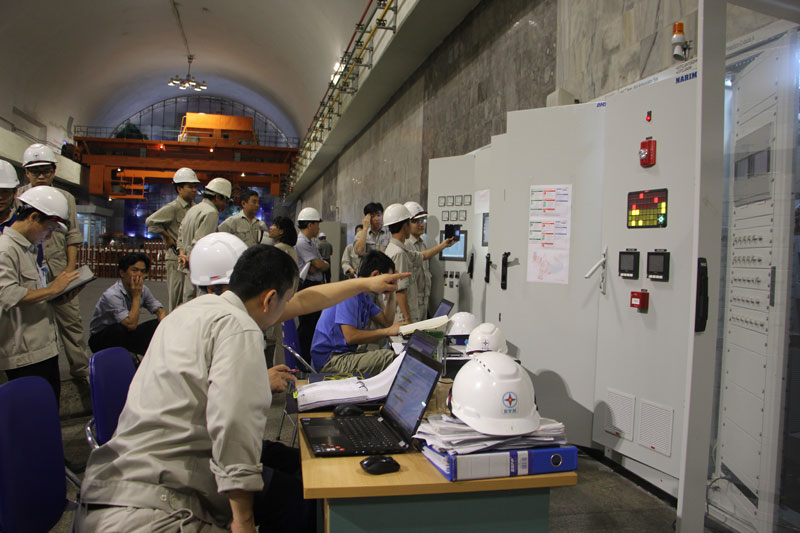
(HBO) – Entering 2017, the Hoa Binh Hydropower Company has encountered a lot of difficulties and challenges, including unfavourable hydrological situation in the early months. The water levels at reservoirs in the Da River in service of the Hoa Binh hydropower plant were over 2m lower than the same period last year.

Director Nguyen Van Minh
(last from right) and a working delegation led by Minister of Agriculture and
Rural Development Nguyen Xuan Cuong and Director General of the Electricity of
Vietnam Dang Hoang An inspect flood discharge at Hoa Binh hydropower plant.
Engineers and workers at a project upgrading the
control system of H7&H8 turbines
Hoa Binh hydropower plant is the pride of the
"shinny river”
The water flowing into the Da river basin is
lower than the average recorded in many previous years, considerably affecting
the power generation of the plant. Apart from generating electricity and
regulating water to prevent droughts and floods, the company is responsible for
repairing equipment and investing in construction. It is implementing a project
to upgrade the control, protection, and measurement system for four turbines.
With the efforts of the whole staff, the company
has completed a large amount of work.
As of August 2017, the company generated 6.98
billion kWh of electricity, fulfilling 70 percent of the yearly target. It also
upgraded the control system for turbines No 7 and No 8 and put them into
operation as scheduled. In January and February, the company increased power
generation for eight turbines and discharged a total of 3.12 billion cubic
meters of water to irrigate the winter-spring crop in the northern delta
region.
To gear up for flood prevention, the company
collected data for analysis and evaluation of the dams’ safety as well as
mapped out plans to prevent natural disasters.
The hydrological situation was quite complicated
in the flood season. Floods came earlier than the same period of previous years
and prolonged from early July to the end of August. The company discharged over
6.5 billion cubic meters of water. The flood discharge was implemented
according to legal regulations.
Besides serving production, the company also deployed
a number of measures to implement a project improving the efficiency of
business production and labour productivity, along with a programme on thrift
practices and wastefulness prevention according to a plan of the Electricity of
Vietnam. Positive outcomes have been achieved.
In the remaining months of this year, the
company will seek to preserve water and ensure sufficient electricity
generation as it was tasked while continuously upgrading the control system of
two turbines.
The company is confident to overcome difficulties
and challenges to fulfill the set targets in 2017.
Dao Village’s honey – a product certified with a 3-star OCOP (One Commune One Product) rating by Thong Nhat Agricultural Cooperative in Dao Village (Hoa Binh City) – is highly regarded by consumers for its quality, richness, and variety in packaging. The distinctively sweet taste of Dao Village’s honey leaves a lasting impression on anyone who has tried it.
In alignment with Project No. 07-DA/TU, issued by the Hoa Binh provincial Party Committee on November 1, 2021, Lac Thuy district has actively promoted investment and supported the sustainable development of its industrial and handicraft sectors during the 2021–2025 period. Alongside this, the district has remained committed to preserving and revitalising traditional craft villages.
Located in the northern part of Lac Thuy district, with a temperate climate and fertile soil, Phu Thanh commune has great potential and advantages in growing tea. The long-standing experience, combined with strict adherence to organic farming practices in the tea gardens, ensures that the dried tea products from Phu Thanh and Lac Thuy as a whole are sold out immediately upon production, providing a stable and prosperous life for the local people.
Amid efforts to streamline the administrative apparatus, Hoa Binh province has intensified measures to address challenges in land clearance, resettlement support, and infrastructure investment, aiming to speed up the progress of key projects.
Hoa Binh province has posted an unprecedented economic growth rate of 12.76% in the first quarter of 2025, marking its highest quarterly performance to date and positioning it as the second fastest-growing locality in the country, trailing only Bac Giang province.
Under current regulations, products in the One Commune – One Product (OCOP) programme that are rated three stars or higher must undergo re-evaluation every three months. However, in reality, some of these products fail to consistently meet the required standards, raising concerns about the sustainability of their OCOP certification. This underscores the urgent need for producers to enhance product quality and gradually develop their OCOP products into strong, marketable brands.





